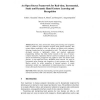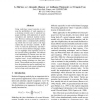53 search results - page 9 / 11 » Spatio-Temporal Pattern Recognition with Neural Networks: Ap... |
BIODATAMINING
2008
13 years 7 months ago
2008
During the past two decades, the field of human genetics has experienced an information explosion. The completion of the human genome project and the development of high throughpu...
HCI
2009
13 years 5 months ago
2009
Real-time, static and dynamic hand gesture learning and recognition makes it possible to have computers recognize hand gestures naturally. This creates endless possibilities in the...
EMNLP
2010
13 years 5 months ago
2010
Using multi-layer neural networks to estimate the probabilities of word sequences is a promising research area in statistical language modeling, with applications in speech recogn...
NIPS
1994
13 years 8 months ago
1994
A self-organizing neural network for sequence classification called SARDNET is described and analyzed experimentally. SARDNET extends the Kohonen Feature Map architecture with act...
TNN
1998
13 years 7 months ago
1998
—Adaptive resonance theory (ART) describes a family of self-organizing neural networks, capable of clustering arbitrary sequences of input patterns into stable recognition codes....


